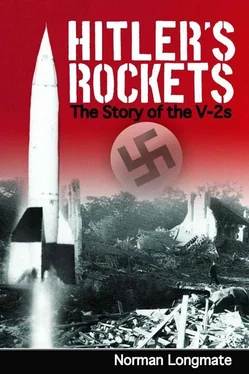Even for established scientists this was totally new territory, and to explore it Dornberger needed men who, like von Braun, combined soaring imagination with a firm grasp of basic scientific principles, accompanied, if possible, by experience in this thinly populated field of technology. Remarkably, he rapidly discovered the ideal person to serve as his test designer and chief engineer, Walter Riedel, then working for the Heylandt company near Berlin, a firm which had actually handled liquid-propelled rockets until a fatal accident had stopped development of their pet project, a rocket-powered racing car. Temperamentally, too, he seemed just what was needed:
Riedel was a short, sedate man, with a permanently dignified and serious expression and a somewhat phlegmatic temperament. He was a most versatile practical engineer. He seemed to me to provide the right counterpoise to the rather temperamental, self-taught technician von Braun. With his calm, deliberate mind, his deep knowledge and his experience in the handling of liquid oxygen he repeatedly managed to guide the bubbling stream of von Braun’s ideas into steadier channels.
The little team began work at the Kummersdorf West Experimental Station, close to an existing firing range in the pine woods seventeen miles south of Berlin. Their accommodation was modest: wooden huts, now converted into ‘improvised offices, a designing room, measurement rooms, darkrooms and a tiny workshop’, where for the first few months ‘everyone was bent over drawing-boards or busy at a lathe’.
Meanwhile, as the pleasant autumn of 1932 gave way to a wintry December and frost flecked the branches of the surrounding pine trees and the raw earth of the scientists’ new home, half an hour’s drive away in Berlin ordinary citizens had more to worry about than either rocket design or the weather. A general election, on 6 November 1932, left the Nazis the largest party in the Reichstag, with 196 seats, well ahead of the Social Democrats’ 121 and the Communists’ 100. Already the brown-shirted stormtroopers swaggered the streets, elbowing Jews into the gutter, and beating up their political rivals. At Kummersdorf, however, the scientists were indifferent to everything except their work. On 21 December 1932, while other German citizens were thinking of Christmas presents and singing ‘Silent Night’, the little group in the clearing amid the Christmas trees were eagerly awaiting the results of the first combustion test of a liquid-powered rocket motor, as Dornberger later described:
The cold bit through the thick soles of my riding boots. It crept up my body until I felt miserably frozen in my short fur jacket. I had snuggled up close to a fir tree. Whenever I showed any sign of abandoning my position I was brought up short by a shout of ‘Keep under cover! Ignition any moment now!’…. In the control room the engineer, Riedel, stood on a narrow wooden grating, grasping two big steering wheels. When pressure was right in the spherical containers a turn of the wheels would open the two main valves and let the fuel into the combustion chamber. At the main door of the test stand, von Braun, very cold, was standing first on one leg and then on the other. He was holding a rod twelve feet long with a mug of petrol fastened to the end. Riedel called out from behind the wall that pressure was now correct and von Braun lit his gigantic match and held the flame under the exhaust….
There was a swoosh, a hiss, and – crash!
Clouds of smoke rose…. Cables, boards, metal sheeting, fragments of steel and aluminium flew whistling through the air…. In the suddenly darkened pit of the testing room a milky, slimy mixture of alcohol and oxygen burned spasmodically with flames of different shapes and sizes, occasionally crackling and detonating like fireworks. Steam hissed. Cables were on fire in a hundred places. Thick, black, stinking fumes of burning rubber filled the air. Von Braun and I stared at each other. We were uninjured. The test stand had been wrecked.
One month later, on 30 January 1933, Hitler became Chancellor of Germany and the Nazi takeover of the state, and its steady preparation for aggressive war, began. On 12 November, in Hitler’s words, ‘the German people restored its honour to itself’, fifteen years after its defeat in 1918, and endorsed Germany’s withdrawal from the League of Nations by a massive 95 per cent vote. A general election on the same day left Nazi-supported candidates forming 92 per cent of the new Reichstag. These events passed the scientists at Kummersdorf by. They were solely exercised, as Dornberger acknowledged, by such problems as how ‘to avoid burning out the chamber and setting the injection nozzles on fire’ when starting up the rocket motor, as had happened during the first test, and by ‘the difficulties of stabilization… as the propellant was consumed’. Their dedication to the task in hand was total. In March 1934 three men were killed while testing a premixed solution of hydrogen peroxide and alcohol though well aware this was highly dangerous, but their leader insisted on going ahead and simply ‘telephoned the Mess… and asked that help should be sent if there were an explosion…. When help came a few minutes later, nothing was left of the test stand except the lead piping of the water supply’. Thereafter such hazardous experiments were discouraged, and these men, wrote Dornberger, conveniently forgetting the thousands of Untermenschen (i.e. non-Germans) who were to perish before his project finally succeeded, ‘were the first and last to give their lives for rocket development under the Army Weapons Department’.
Every advance brought some new problem in its train. A promising plan to use the exhaust gases to steer the rocket’s rudders, for example, came up against the existing limits of metallurgical knowledge. There was, it seemed, no ‘material which… would not melt, like butter in the sun, at a gas velocity of almost 6500 feet per second’. But, looking back, Dornberger had no doubt that this was the happiest period of the whole vast and protracted enterprise:
The early years of our activity shine in my memory with imperishable lustre. They were years of groping towards creation, of the delight of success, of progressive work in common among inseparable companions…. Luckily the difficulties were for the most part still entirely unknown to us. We attacked our problems with the courage of inexperience and had no thought of the time it might take us to solve them.
Although money for military research was now plentiful, and the Army Weapons Department could order without difficulty any scientific equipment needed, the full implications of the new regime had not yet sunk in among the bureaucrats in Berlin. The supply of office machinery, for example, still required Treasury approval, and to avoid intolerable delays the Kummersdorf scientists were forced to resort to such devices as describing a pencil sharpener as an ‘appliance for cutting wood rods up to 10 mm in diameter’ and a typewriter as an ‘instrument for recording test data with recording roller’. There was an epic battle over an order for two boxes of children’s sparklers, which were being tried as a means of igniting the rocket’s fuel mixture. In the hope of saving time they were said to be needed for the office Christmas tree, but a whole year later some vigilant official observed that they had been ordered in midsummer, the correspondence being terminated only when he was told bluntly they were for ‘secret experiments’ and no further questions could be answered.
With the problems of fuel and combustion in process of being solved, at least experimentally, those of guiding the rocket once it had taken off became equally pressing, until von Braun discovered in the Gyroscope Company at Brietz near Berlin a former Austrian naval officer ‘full of ideas and far ahead of his time in all questions relating to gyroscopes’. The development of this system of keeping the rocket stable and on course was another major breakthrough, for, Dornberger learned, ‘according to the standard Textbook of Ballistics experiments had proved it impossible to impart a steady flight to bodies with arrow-stability at supersonic speed, but supersonic speed was needed to obtain access to space’. Eventually it became clear that no single gyroscope would suffice, but one working simultaneously ‘on three axes’.
Читать дальше






![Traudl Junge - Hitler's Last Secretary - A Firsthand Account of Life with Hitler [aka Until the Final Hour]](/books/416681/traudl-junge-hitler-s-last-secretary-a-firsthand-thumb.webp)





